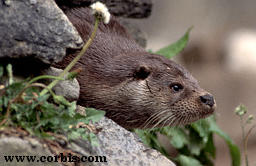
Order: Carnivora
Family: Mustelidae
Genus & Species: Lutra lutra
APPEARANCE
European otters are small members of the weasel family that have taken to
water. They grow to a length of 2-3 ft with a height of 12 in. The tail length
is 1.4-1.6 in. Males are heavier than females, with the females weighing
12-33 lbs.
European otters have a sleek, streamlined body with a thick tail that tapers
to a point. The ears are small and the nose is shaped like a hexagon. The
limbs are short and the feet are webbed, the toes ending in sharp claws.
Long whiskers are located on each side of the snout and are very sensitive
to touch. The sense of sight, smell and hearing is acute. The eyes are located
at the top of the head.
European otters are dusky brown in colour with a lighter-coloured belly.
The guard hairs are long, .68 in, and the underfur is shorter. The guard
hairs are stiff and coarse and covered in an oil that the European otter
produces. This oil acts as a water repellent and is so effective that the skin
never gets wet.
European otters have flaps over their ears and nose that close shut while the
otter is swimming. However, the eyes remain open. They can hold their
breath for 20 seconds and can swim underwater for 1300 ft.
European otters have a life span of 9-10 years. They communicate with
whistles and snarls.
HABITAT
European otters are found throughout most of Europe, including the UK,
Ireland, Germany, France, Italy, Scandinavia, Spain, and Portugal. They
are also located throughout most of Asia but are absent from northern
Russia and southern Asia, including all of India. European otters can also
be found on the northern tip of Africa.
European otters spend most of their lives in freshwater, away from human
contact. They can be found in rivers, lakes, ponds, streams, and along rocky
coasts. They are mostly nocturnal and live solitary lives except while
mating. Males require a territory of 10 miles of undisturbed riverbank.
FOOD
European otters eat fish, eels, insects, birds, frogs, baby rabbits, and
crustaceans. European otters living along coastal waters feed mostly on
crabs and dogfish. They hunt by cornering their prey in weeds and catching
them in their mouths. They feed on their catch immediately after they reach
the shore.
BREEDING
Sexual maturity is reached at 18 months for males and 2 years for females.
European otters mate at any time of the year. The males will mate with
more than one female, staying with each female in her den. An average of
2-3 pups are born after a gestation period of 61-74 days. Anywhere from 1-6
pups in a litter have been known. The pups are born blind and naked and
only 4 in. long in a burrow called a holt. They are helpless for their first six
weeks and are taken care of by the female. They will stay with their mother
for 13-15 months before becoming independent.
ENEMIES
The European otter has no known enemy but man. In the 1950's they were
common throughout all of their range. After extensive hunting by man for
sport, their fur, or to protect the salmon stocks, they were all but eliminated
throughout most of Europe. Today it is illegal to hunt European otters, as
they are so rare. They have an "endangered" status in Europe. Today their
numbers are increasing very slowly due to habitat loss, traffic injuries, and
chemical pollution. Conservation efforts in the UK and Scandinavia include
releasing otters born in captivity back into the wild.
RELATIVES
The European otter is a type of river otter and is related to the North
American river otter. There are 10 subspecies of the European otter and
most of them are endangered.
RESOURCES CITED
1. "European Otter" Wildlife Fact File, USA
2. "Save the European Otter" Wildlife Fact File, USA
3. otternet.com/species/otter.htm
4. www.bornfree.org.uk/edu-oter.htm
5. 193.114.240.88/wildplaces/otter.html
6. www.ambio.kva.se/1997/Nr4_97/jun97_1.html
7. hyperion.advanced.org/11601/media/links/europele_ otter.html Back
Back